2003 FORD WINDSTAR check engine light
[x] Cancel search: check engine lightPage 199 of 240
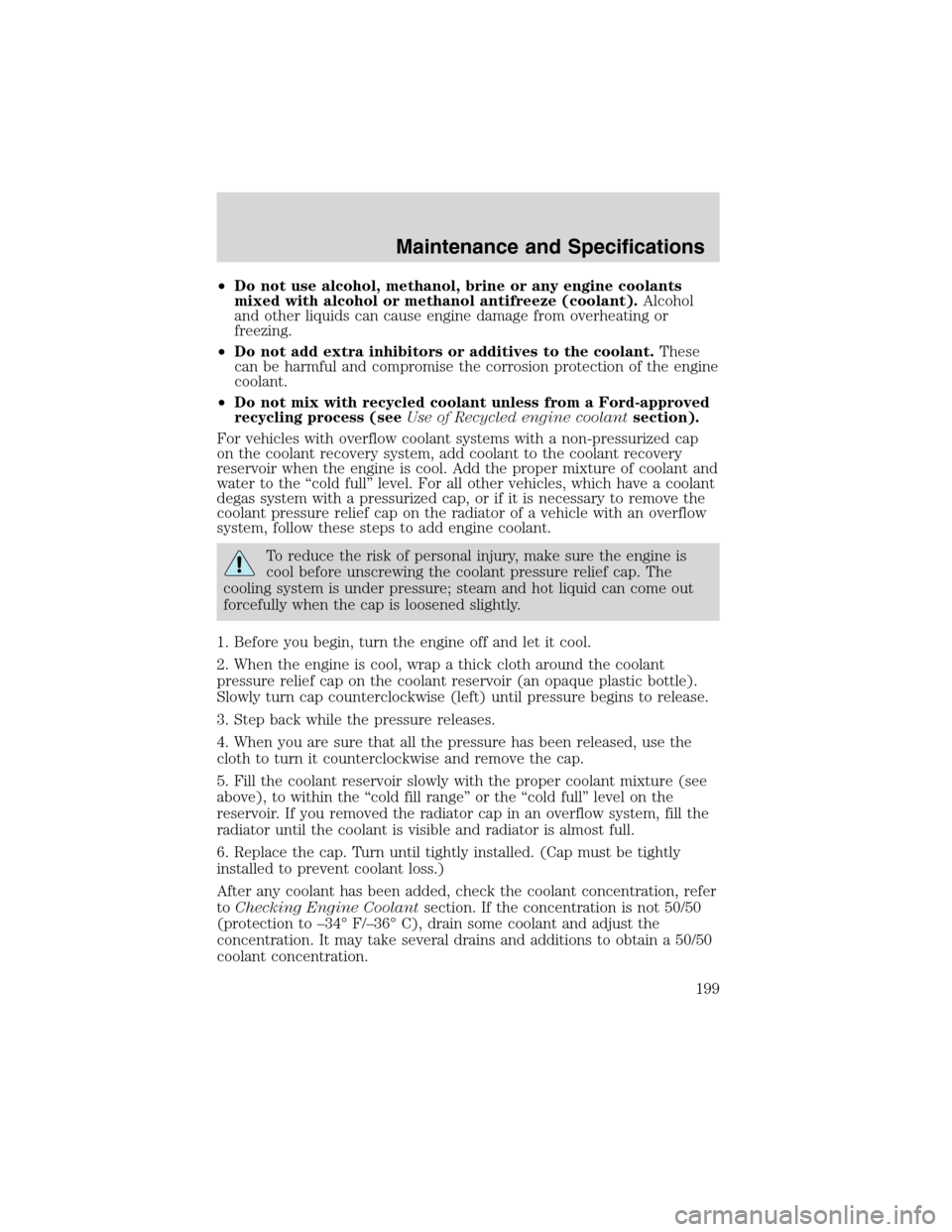
•Do not use alcohol, methanol, brine or any engine coolants
mixed with alcohol or methanol antifreeze (coolant).Alcohol
and other liquids can cause engine damage from overheating or
freezing.
•Do not add extra inhibitors or additives to the coolant.These
can be harmful and compromise the corrosion protection of the engine
coolant.
•Do not mix with recycled coolant unless from a Ford-approved
recycling process (seeUse of Recycled engine coolantsection).
For vehicles with overflow coolant systems with a non-pressurized cap
on the coolant recovery system, add coolant to the coolant recovery
reservoir when the engine is cool. Add the proper mixture of coolant and
water to the“cold full”level. For all other vehicles, which have a coolant
degas system with a pressurized cap, or if it is necessary to remove the
coolant pressure relief cap on the radiator of a vehicle with an overflow
system, follow these steps to add engine coolant.
To reduce the risk of personal injury, make sure the engine is
cool before unscrewing the coolant pressure relief cap. The
cooling system is under pressure; steam and hot liquid can come out
forcefully when the cap is loosened slightly.
1. Before you begin, turn the engine off and let it cool.
2. When the engine is cool, wrap a thick cloth around the coolant
pressure relief cap on the coolant reservoir (an opaque plastic bottle).
Slowly turn cap counterclockwise (left) until pressure begins to release.
3. Step back while the pressure releases.
4. When you are sure that all the pressure has been released, use the
cloth to turn it counterclockwise and remove the cap.
5. Fill the coolant reservoir slowly with the proper coolant mixture (see
above), to within the“cold fill range”or the“cold full”level on the
reservoir. If you removed the radiator cap in an overflow system, fill the
radiator until the coolant is visible and radiator is almost full.
6. Replace the cap. Turn until tightly installed. (Cap must be tightly
installed to prevent coolant loss.)
After any coolant has been added, check the coolant concentration, refer
toChecking Engine Coolantsection. If the concentration is not 50/50
(protection to–34°F/–36°C), drain some coolant and adjust the
concentration. It may take several drains and additions to obtain a 50/50
coolant concentration.
Maintenance and Specifications
199
Page 208 of 240
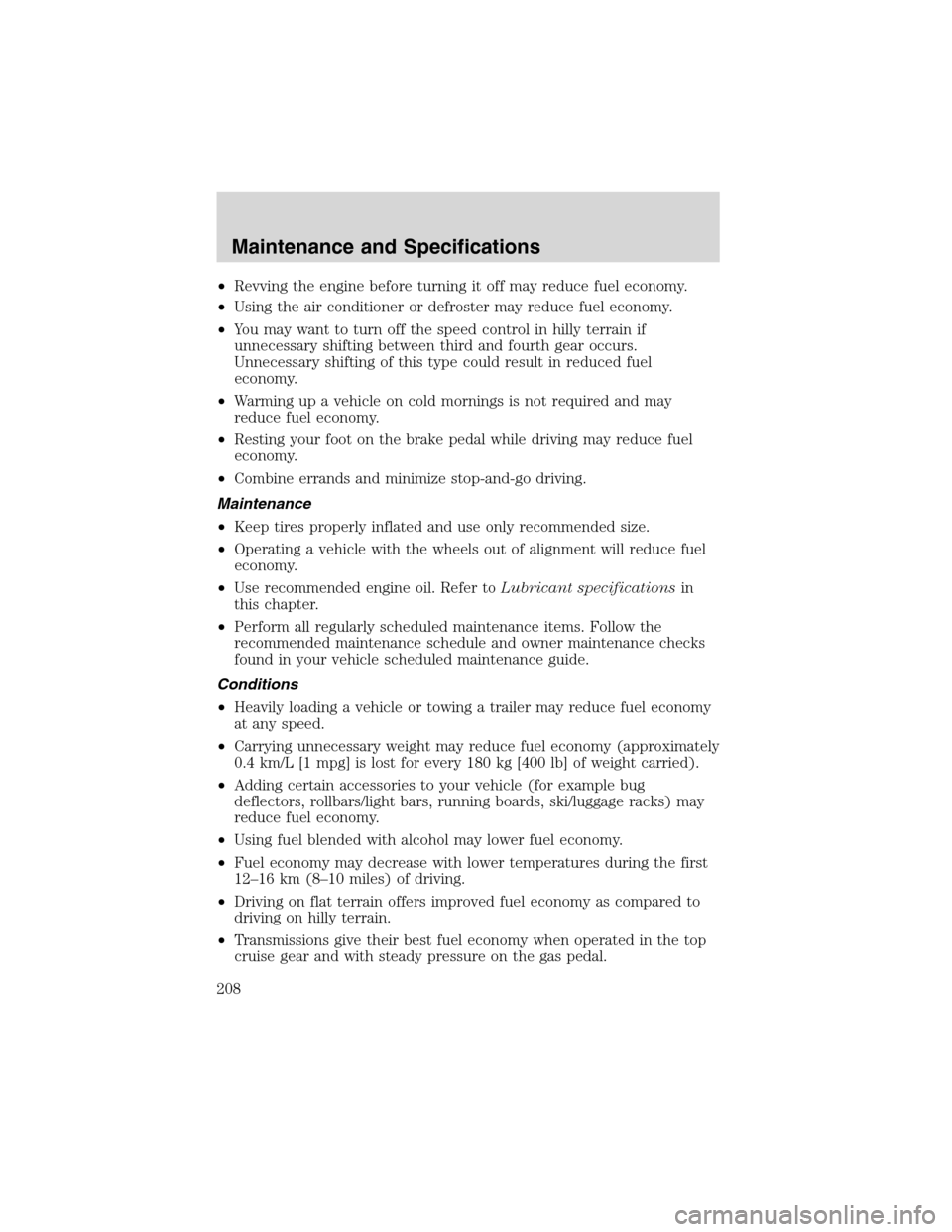
•Revving the engine before turning it off may reduce fuel economy.
•Using the air conditioner or defroster may reduce fuel economy.
•You may want to turn off the speed control in hilly terrain if
unnecessary shifting between third and fourth gear occurs.
Unnecessary shifting of this type could result in reduced fuel
economy.
•Warming up a vehicle on cold mornings is not required and may
reduce fuel economy.
•Resting your foot on the brake pedal while driving may reduce fuel
economy.
•Combine errands and minimize stop-and-go driving.
Maintenance
•Keep tires properly inflated and use only recommended size.
•Operating a vehicle with the wheels out of alignment will reduce fuel
economy.
•Use recommended engine oil. Refer toLubricant specificationsin
this chapter.
•Perform all regularly scheduled maintenance items. Follow the
recommended maintenance schedule and owner maintenance checks
found in your vehicle scheduled maintenance guide.
Conditions
•Heavily loading a vehicle or towing a trailer may reduce fuel economy
at any speed.
•Carrying unnecessary weight may reduce fuel economy (approximately
0.4 km/L [1 mpg] is lost for every 180 kg [400 lb] of weight carried).
•Adding certain accessories to your vehicle (for example bug
deflectors, rollbars/light bars, running boards, ski/luggage racks) may
reduce fuel economy.
•Using fuel blended with alcohol may lower fuel economy.
•Fuel economy may decrease with lower temperatures during the first
12–16 km (8–10 miles) of driving.
•Driving on flat terrain offers improved fuel economy as compared to
driving on hilly terrain.
•Transmissions give their best fuel economy when operated in the top
cruise gear and with steady pressure on the gas pedal.
Maintenance and Specifications
208
Page 209 of 240
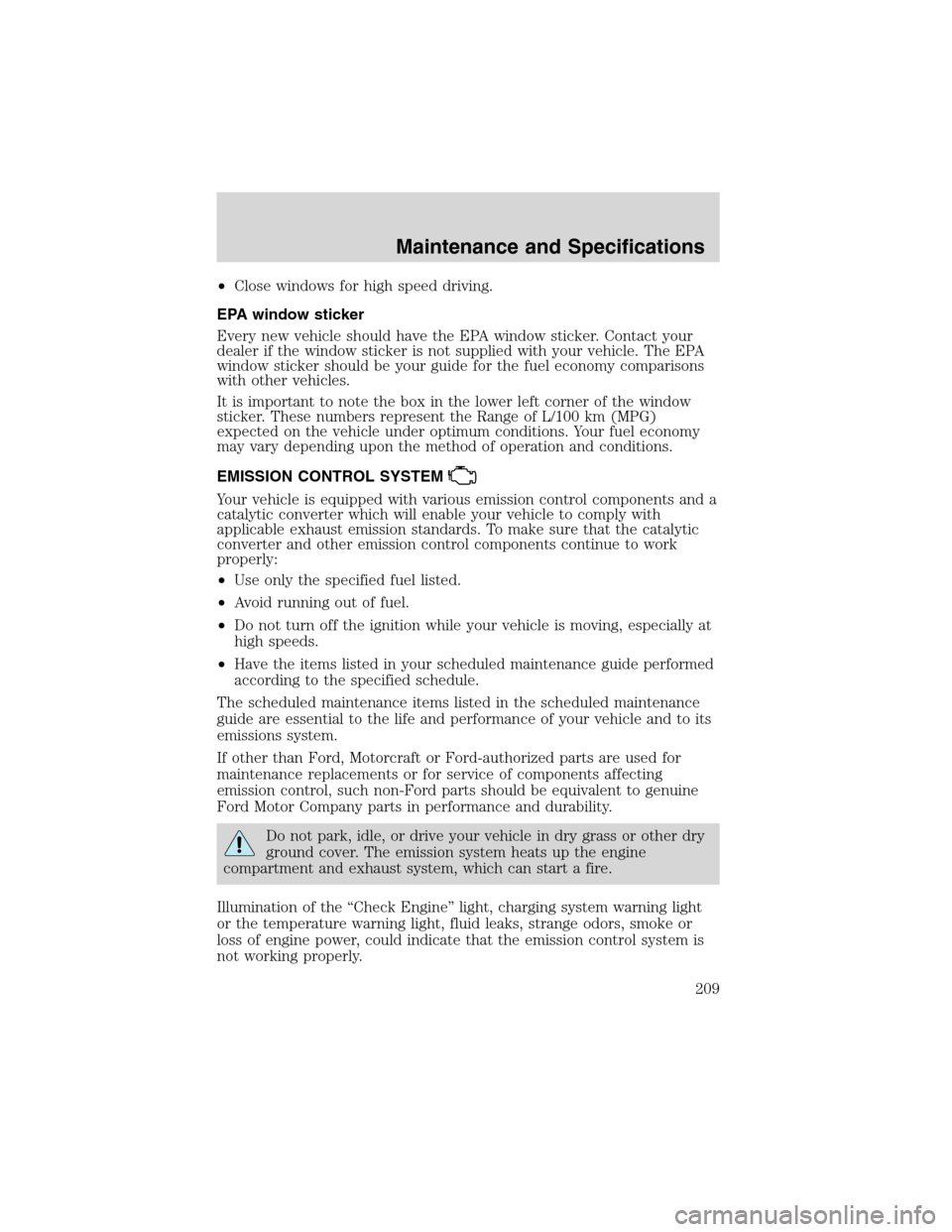
•Close windows for high speed driving.
EPA window sticker
Every new vehicle should have the EPA window sticker. Contact your
dealer if the window sticker is not supplied with your vehicle. The EPA
window sticker should be your guide for the fuel economy comparisons
with other vehicles.
It is important to note the box in the lower left corner of the window
sticker. These numbers represent the Range of L/100 km (MPG)
expected on the vehicle under optimum conditions. Your fuel economy
may vary depending upon the method of operation and conditions.
EMISSION CONTROL SYSTEM
Your vehicle is equipped with various emission control components and a
catalytic converter which will enable your vehicle to comply with
applicable exhaust emission standards. To make sure that the catalytic
converter and other emission control components continue to work
properly:
•Use only the specified fuel listed.
•Avoid running out of fuel.
•Do not turn off the ignition while your vehicle is moving, especially at
high speeds.
•Have the items listed in your scheduled maintenance guide performed
according to the specified schedule.
The scheduled maintenance items listed in the scheduled maintenance
guide are essential to the life and performance of your vehicle and to its
emissions system.
If other than Ford, Motorcraft or Ford-authorized parts are used for
maintenance replacements or for service of components affecting
emission control, such non-Ford parts should be equivalent to genuine
Ford Motor Company parts in performance and durability.
Do not park, idle, or drive your vehicle in dry grass or other dry
ground cover. The emission system heats up the engine
compartment and exhaust system, which can start a fire.
Illumination of the“Check Engine”light, charging system warning light
or the temperature warning light, fluid leaks, strange odors, smoke or
loss of engine power, could indicate that the emission control system is
not working properly.
Maintenance and Specifications
209
Page 210 of 240
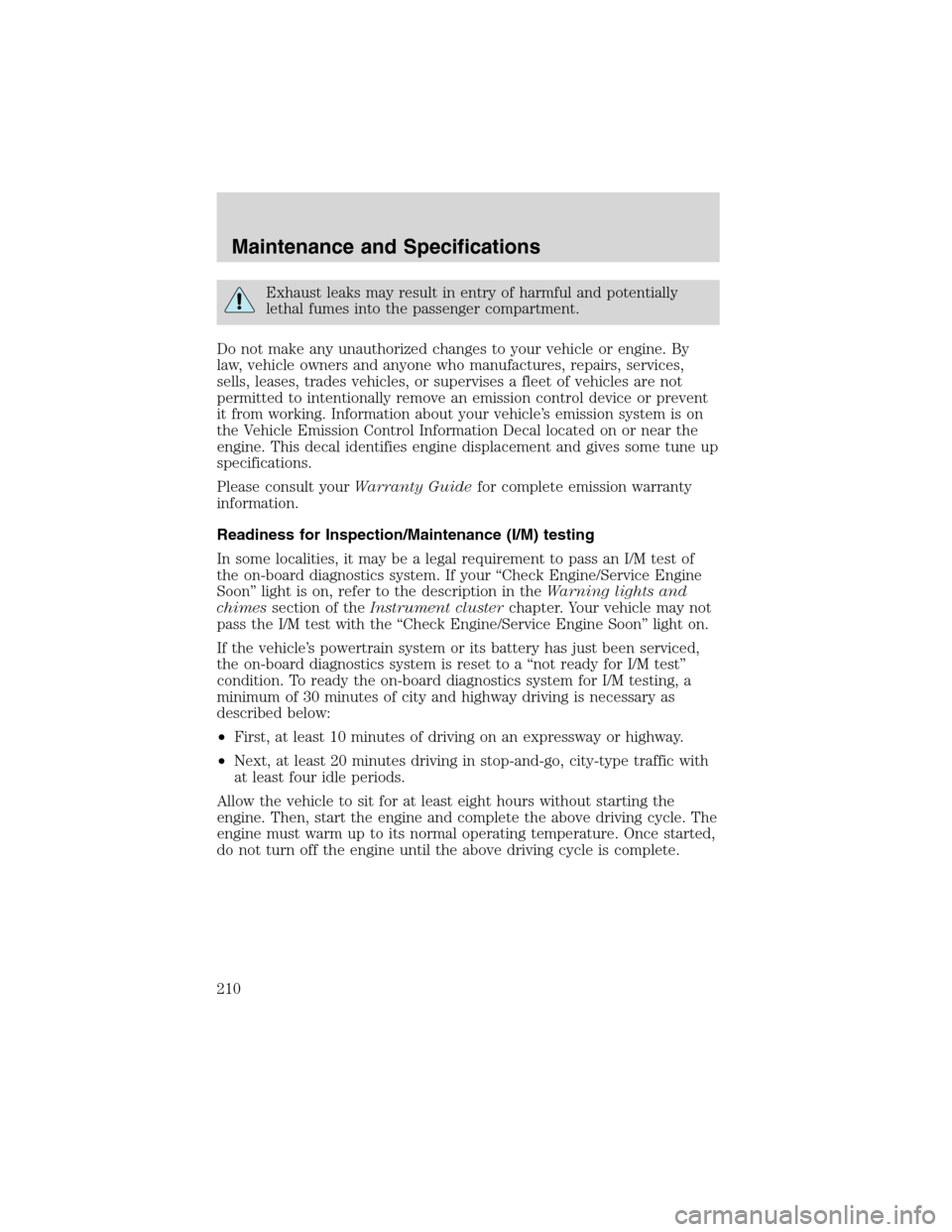
Exhaust leaks may result in entry of harmful and potentially
lethal fumes into the passenger compartment.
Do not make any unauthorized changes to your vehicle or engine. By
law, vehicle owners and anyone who manufactures, repairs, services,
sells, leases, trades vehicles, or supervises a fleet of vehicles are not
permitted to intentionally remove an emission control device or prevent
it from working. Information about your vehicle’s emission system is on
the Vehicle Emission Control Information Decal located on or near the
engine. This decal identifies engine displacement and gives some tune up
specifications.
Please consult yourWarranty Guidefor complete emission warranty
information.
Readiness for Inspection/Maintenance (I/M) testing
In some localities, it may be a legal requirement to pass an I/M test of
the on-board diagnostics system. If your“Check Engine/Service Engine
Soon”light is on, refer to the description in theWarning lights and
chimessection of theInstrument clusterchapter. Your vehicle may not
pass the I/M test with the“Check Engine/Service Engine Soon”light on.
If the vehicle’s powertrain system or its battery has just been serviced,
the on-board diagnostics system is reset to a“not ready for I/M test”
condition. To ready the on-board diagnostics system for I/M testing, a
minimum of 30 minutes of city and highway driving is necessary as
described below:
•First, at least 10 minutes of driving on an expressway or highway.
•Next, at least 20 minutes driving in stop-and-go, city-type traffic with
at least four idle periods.
Allow the vehicle to sit for at least eight hours without starting the
engine. Then, start the engine and complete the above driving cycle. The
engine must warm up to its normal operating temperature. Once started,
do not turn off the engine until the above driving cycle is complete.
Maintenance and Specifications
210
Page 230 of 240
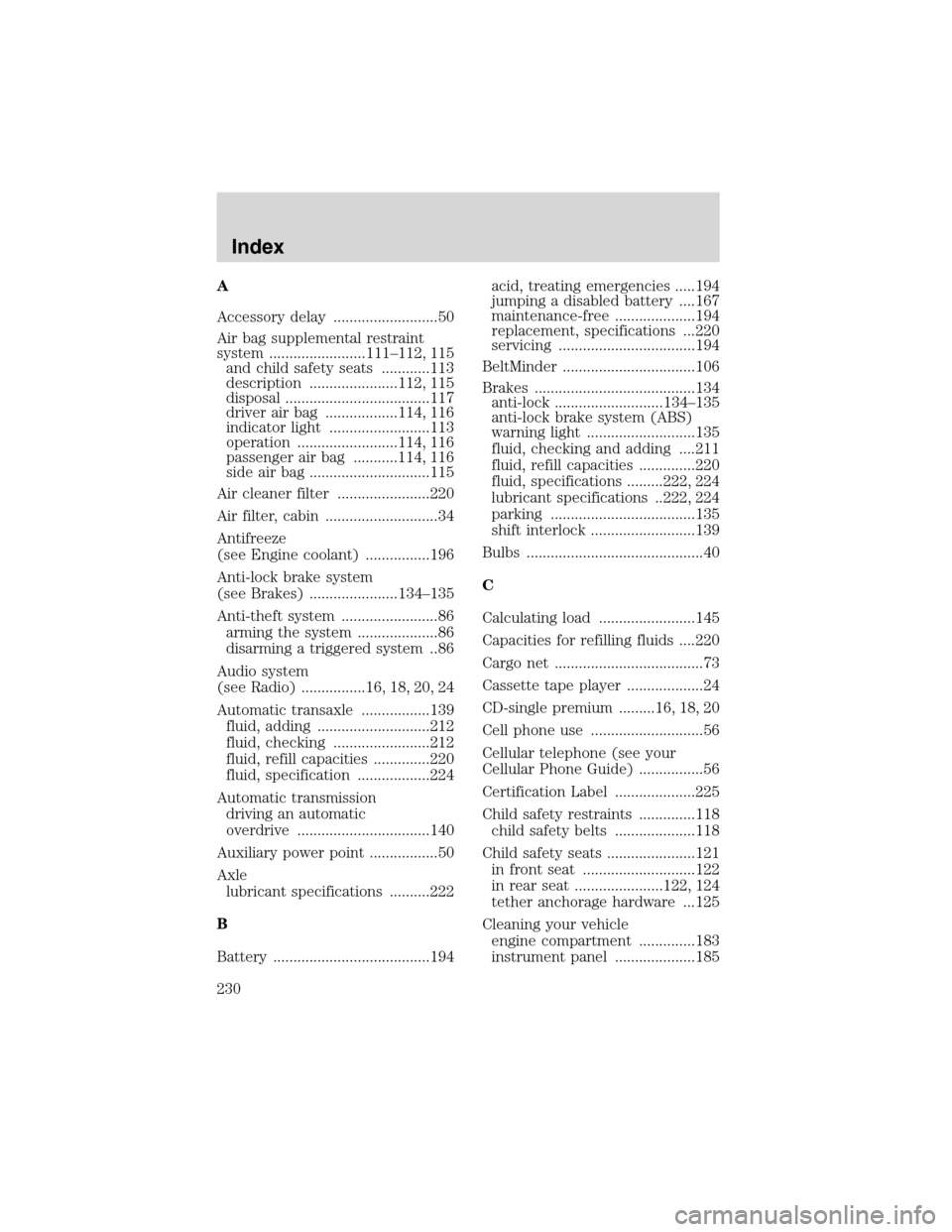
A
Accessory delay ..........................50
Air bag supplemental restraint
system ........................111–112, 115
and child safety seats ............113
description ......................112, 115
disposal ....................................117
driver air bag ..................114, 116
indicator light .........................113
operation .........................114, 116
passenger air bag ...........114, 116
side air bag ..............................115
Air cleaner filter .......................220
Air filter, cabin ............................34
Antifreeze
(see Engine coolant) ................196
Anti-lock brake system
(see Brakes) ......................134–135
Anti-theft system ........................86
arming the system ....................86
disarming a triggered system ..86
Audio system
(see Radio) ................16, 18, 20, 24
Automatic transaxle .................139
fluid, adding ............................212
fluid, checking ........................212
fluid, refill capacities ..............220
fluid, specification ..................224
Automatic transmission
driving an automatic
overdrive .................................140
Auxiliary power point .................50
Axle
lubricant specifications ..........222
B
Battery .......................................194acid, treating emergencies .....194
jumping a disabled battery ....167
maintenance-free ....................194
replacement, specifications ...220
servicing ..................................194
BeltMinder .................................106
Brakes ........................................134
anti-lock ...........................134–135
anti-lock brake system (ABS)
warning light ...........................135
fluid, checking and adding ....211
fluid, refill capacities ..............220
fluid, specifications .........222, 224
lubricant specifications ..222, 224
parking ....................................135
shift interlock ..........................139
Bulbs ............................................40
C
Calculating load ........................145
Capacities for refilling fluids ....220
Cargo net .....................................73
Cassette tape player ...................24
CD-single premium .........16, 18, 20
Cell phone use ............................56
Cellular telephone (see your
Cellular Phone Guide) ................56
Certification Label ....................225
Child safety restraints ..............118
child safety belts ....................118
Child safety seats ......................121
in front seat ............................122
in rear seat ......................122, 124
tether anchorage hardware ...125
Cleaning your vehicle
engine compartment ..............183
instrument panel ....................185
Index
230
Page 233 of 240

K
Keyless entry system .................81
autolock .....................................81
Keys
positions of the ignition .........131
L
Lamps
autolamp system .......................35
bulb replacement
specifications chart ..................40
cargo lamps ...............................36
daytime running light ...............35
headlamps .................................35
headlamps, flash to pass ..........36
instrument panel, dimming .....36
interior lamps .....................38–39
replacing bulbs .............40, 42–43
Lane change indicator
(see Turn signal) ........................38
Liftgate ..................................72–73
Lights, warning and indicator ....10
anti-lock brakes (ABS) ..........135
Load limits .................................144
GAWR ......................................144
GVWR ......................................144
trailer towing ..........................144
Locks
autolock .....................................81
childproof ..................................76
Low tire warning .................13, 215
Lubricant specifications ...222, 224
Lumbar support, seats ...............89
M
Message center ...........................62english/metric button ...............63
system check button ................63
warning messages .....................65
Mirrors .........................................46
automatic dimming rearview
mirror ........................................51
fold away ...................................52
heated ........................................52
side view mirrors (power) .......51
Motorcraft parts ................205, 220
O
Octane rating ............................204
Oil (see Engine oil) ..................191
Overdrive ...................................139
P
Parking brake ............................135
Parts (see Motorcraft parts) ....220
Passenger Occupant
Classification Sensor ...................99
Pedals (see Power adjustable
foot pedals) .................................53
Power adjustable foot pedals .....53
Power distribution box
(see Fuses) ...............................157
Power door locks ..................75, 81
Power mirrors .............................51
Power point .................................50
Power steering ..........................138
fluid, checking and adding ....211
fluid, refill capacity ................220
fluid, specifications .........222, 224
Power Windows ...........................50
R
Radio ..........................16, 18, 20, 24
Index
233